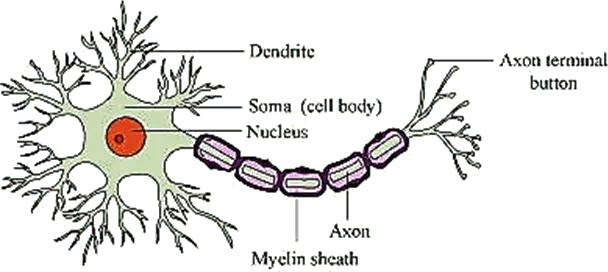NCERT Solutions for Class 11 Biology Chapter 18 - Neural Control and Coordination
The NCERT Solutions for Class 11 Biology Chapter 18 Neural Control and Coordination explain how the brain and nervous system work. This includes voluntary and involuntary actions, reflexes, and functions of different organs of the human body. Neural control and coordination are important for controlling body functions and giving a reaction to stimuli. With the help of NCERT Solutions, students can understand the difficult concepts easily and build a strong base in this subject.
This Story also Contains
- Download Neural Control and Coordination Class 11 Questions and Answers PDF
- Access Class 11 Biology Chapter 18 Neural Control and Coordination Question Answer
- Approach to Solve Neural Control and Coordination Class 11 Question Answer
- Important Questions of NCERT Class 11 Biology Chapter 18 Neural Control and Coordination
- What Students Learn from Neural Control and Coordination NCERT Solutions?
- Why Class 11 Biology Chapter 18 Neural Control and Coordination NCERT Solutions are Important?
- What Extra Should Students Study Beyond the NCERT for NEET?
- NCERT Solutions for Class 11 Biology - Chapter Wise
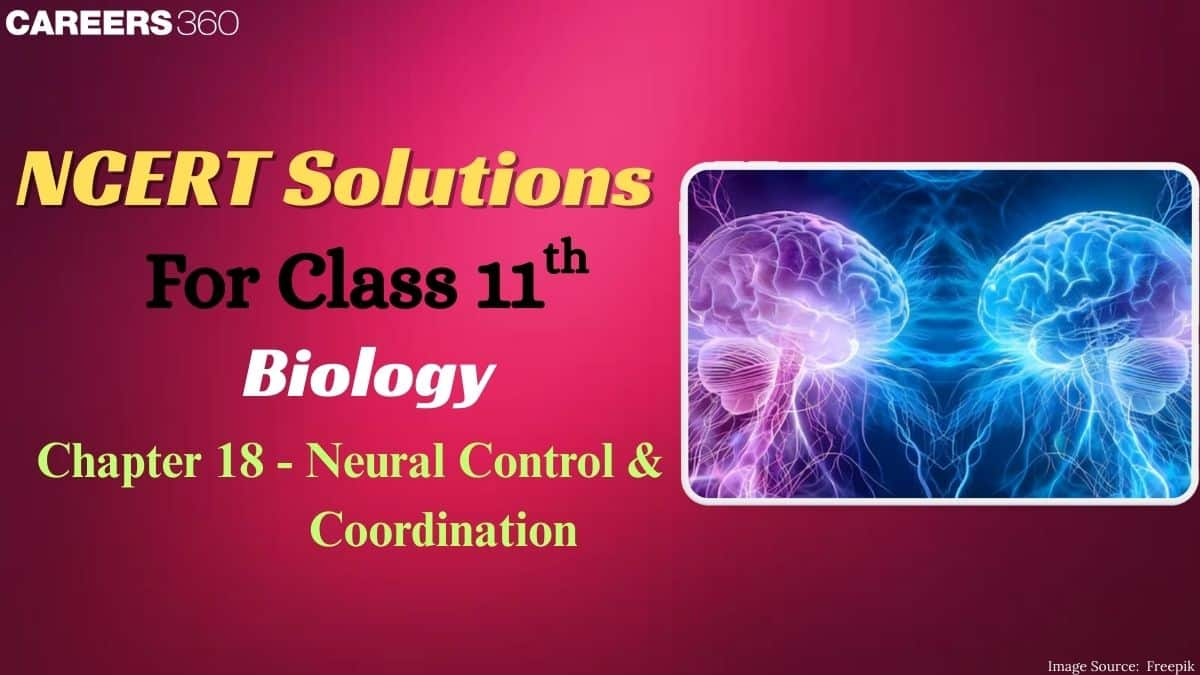
The Neural Control and Coordination Class 11 question answer describes the structure and functions of neurons. Well-labeled diagrams of the human brain, including the midbrain, forebrain, and hindbrain, and neuron is provided by our subject experts. The Neural Control and Coordination Class 11 Questions and Answers PDF also discusses sensory and motor pathways, reflex arcs, and how the body maintains homeostasis. The solutions follow the latest NCERT curriculum, so students do not miss anything for their exams.
Download Neural Control and Coordination Class 11 Questions and Answers PDF
Students can download the PDF easily from the link given below. The Neural Control and Coordination Class 11 Questions and Answers PDF can be accessed offline and used anytime, anywhere for quick revision. Language used in the NCERT Solutions for Class 11 is simple and clear to make learning effective.
Also, Read
Access Class 11 Biology Chapter 18 Neural Control and Coordination Question Answer
The detailed solutions for in-text and exercise questions are provided below. These solutions give a clear overview of how the brain and nervous system work. Referring to the Class 11 Biology Chapter 18 Neural Control and Coordination question answer also boosts confidence and improves performance.
Q1. Briefly describe the structure of the brain.
Answer:
The brain is the main coordinating center of the body. It is a part of the nervous system that controls and monitors every organ of the body.
It is well protected by cranial meninges, an outer layer called dura mater, a thin middle layer called arachnoid, and an inner layer called pia mater.
It is divided into three regions —
Forebrain: Forebrain is the largest part of the brain. It includes the cerebrum (thinking and memory), the thalamus (sensory-motor coordination), and the hypothalamus (body temperature, hunger, thirst, and emotions).
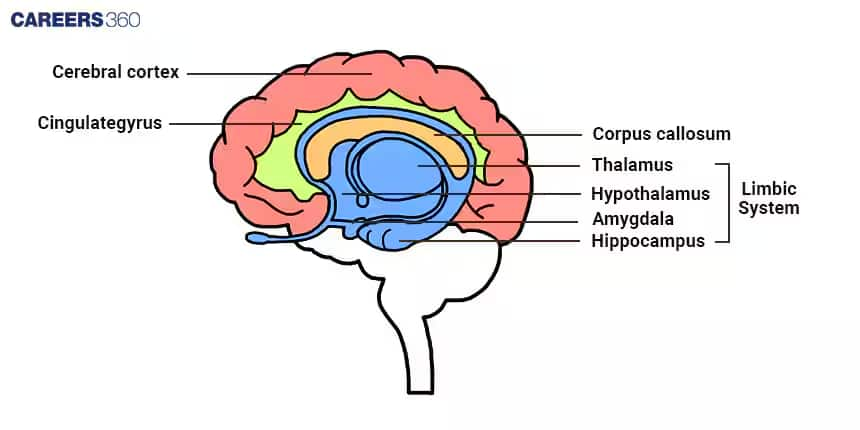
Midbrain: Connects the forebrain and hindbrain. It helps process visual and auditory information and controls some movements and reflexes.
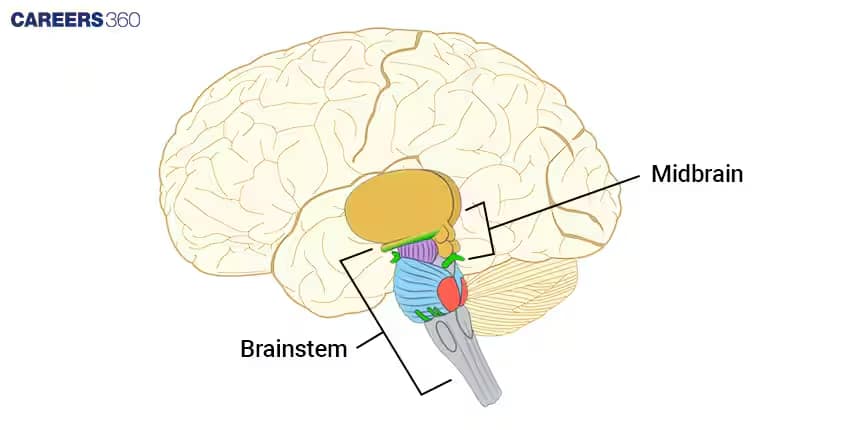
Hindbrain: Controls basic life functions like breathing, heartbeat, and balance. It has three parts: the pons (connects parts of the brain), the cerebellum (balance and coordination), and the medulla oblongata (controls heart rate, breathing, and other automatic functions).
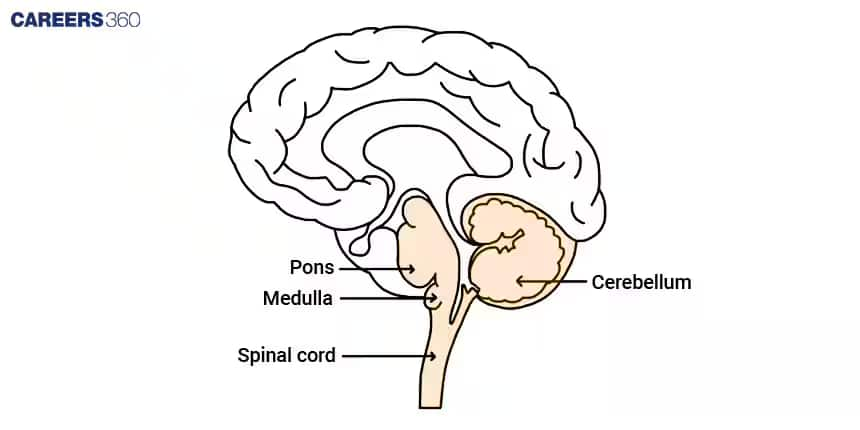
Q2. Compare the following:
(a) Central nervous system (CNS) and Peripheral nervous system (PNS)
Answer: The major difference between the Central Nervous System (CNS) and the Peripheral Nervous System (PNS) is discussed below in the table:
| Central Neural System (CNS) | Peripheral Neural System (PNS) |
| 1. The CNS is made up of the brain and the spinal cord. | 1. PNS consists of cranial nerves and spinal nerves. |
| 2. The brain is protected by the skull, and the spinal cord by the vertebral column. | 2. There are no protective structures for PNS. |
| 3. CNS does not have any subdivisions. | 3. PNS is divided into the somatic nervous system and the autonomic nervous system. |
| 4. CNS processes the information and controls the response to impulses. | 4. Nerves of the PNS carry impulses to the CNS and responses from the CNS to different organs of the body. |
| 5. The group of neurons in the CNS is called the nucleus. | 5. The group of neurons in the PNS is called a ganglion. |
(b) Resting potential and action potential
Answer:
| Resting Potential | Action Potential |
| 1. It is the potential difference (difference in electric charge) across the membrane when the neuron is in the resting phase. | 1. It is the potential difference (difference in the electric charge) across the membrane when the neuron is stimulated or excited. |
| 2. The outer side of the neuron is positively charged, and the interior of the neuron is negatively charged. | 2. The outer side of the neuron is negatively charged, and the interior of the neuron is positively charged. |
| 3. The plasma membrane of the neuron is more permeable to K+ ions. | 3. The plasma membrane of the neuron is more permeable to Na+ ions. |
| 4. The sodium-potassium-ATPase pump is active and sends Na+ ions outside the neuron to maintain the resting potential. | 4. The sodium-potassium-ATPase pump functions in a reverse manner and sends Na+ ions into the neuron. |
(a) Polarisation of the membrane of a nerve fibre
Answer:
Polarisation of the membrane of a nerve fiber:
When the nerve fiber is in the resting phase, it is said to be in the polarised state. In a polarised state, the membrane of the nerve fiber experiences a resting potential. The following steps take place during the process of polarisation of the membrane of a nerve fiber:
- When a depolarised region of a nerve fiber starts becoming polarised initially, there are more K+ ions outside the nerve fiber, and the axon membrane contains a large amount of Na+ ions.
- As the region of the membrane starts attaining the polarised state, the membrane becomes more permeable to K+ ions and impermeable to Na+ ions and negatively charged proteins.
- 3Na+ ions are sent outside the axon, and 2K+ ions are sent into the axon by a sodium-potassium pump by active transport.
- The inner side of the membrane becomes electronegative (negatively charged) and the outer side becomes electropositive (positively charged) because of the movement of sodium and potassium ions. This makes the nerve fiber polarised.
Q3. Explain the process:
(b) Depolarisation of the membrane of a nerve fiber
Answer:
When the nerve fiber is stimulated, it is said to be in a depolarized state. In a depolarised state, the membrane of the nerve fiber experiences an action potential. The following steps take place during the process of depolarisation of the membrane of a nerve fiber:
- In a polarised state, the axon has a higher concentration of K+ ions, and outside the axon, the concentration of Na+ ions is higher.
- When the nerve fiber gets excited by the stimulus, the permeability of the membrane for Na+ ions and K+ ions is reversed.
- The membrane becomes highly permeable for Na+ ions.
- There is a rapid influx of Na+ ions into the axon.
- This makes the inner side of the membrane positively charged, and the outside of the membrane becomes negatively charged.
- This results in depolarisation of the membrane of the nerve fiber, and it experiences an action potential.
Q3. Explain the process:
(c) Transmission of a nerve impulse across a chemical synapse
Answer:
A synapse is the junction between two nerve cells (neurons).
- In a chemical synapse, there is always a small gap called the synaptic cleft between the two neurons.
- When a nerve impulse reaches the end of the first neuron (pre-synaptic neuron), calcium ions enter and cause tiny sacs (vesicles) to release a chemical called acetylcholine into the gap.
- Acetylcholine crosses the gap and attaches to receptors on the next neuron (post-synaptic neuron).
- This allows sodium to enter and potassium to leave the next neuron, creating a new nerve impulse.
- The signal is then passed on to the next neuron.
(b) Brain
Answer:
Brain-
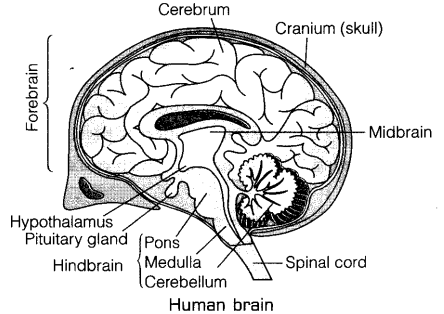
Q5. Write short notes on the following:
(a) Neural coordination
Answer:
Coordination helps different organs work together in living things. In humans, coordination happens in two ways: neural and chemical. Neural coordination uses special cells called neurons to send messages quickly.
Neurons connect receptors (which sense things) to effectors (which respond).
This system controls body actions, like moving muscles or activating glands.
It helps us remember, learn, think, and reason.
Neural coordination also manages vital functions like breathing, heartbeat, and digestion.
By linking all these processes, it keeps the body balanced and working well.
Q5. Write short notes on the following:
(b) Forebrain
Answer:
The forebrain has three main parts: the cerebrum, thalamus, and hypothalamus. The cerebrum is the biggest part and controls thinking, memory, and actions.
The cerebrum is split into two halves and joined by nerve fibers.
It has grey matter (outer layer) for thinking and white matter (inner part) for sending signals.
The limbic system, located within the cerebrum, is responsible for handling emotions and memory.
The thalamus passes messages between the body and brain and helps with emotions and senses.
It helps us feel things like heat, cold, and pain.
The hypothalamus keeps the body balanced.
It controls hunger, thirst, sleep, and temperature.
It also manages hormones and emotions.
Q5. Write short notes on the following:
(c) Midbrain
Answer:
The midbrain has two main parts: the cerebral peduncles and the corpora quadrigemina. The cerebral peduncles are thick nerve bundles that connect the cerebrum and cerebellum.
They help carry sensory and motor signals between the forebrain and hindbrain.
The corpora quadrigemina are two pairs of lobes on the back of the midbrain.
The superior colliculi control visual reflexes, like moving your head and eyes towards something you see.
The inferior colliculi manage auditory reflexes, helping you turn your head towards sounds.
Q5 . Write short notes on the following:
(d) Hindbrain
Answer:
The hindbrain has three main parts: the cerebellum, pons Varolii, and medulla oblongata. The cerebellum is at the back of the brain.
It has an outer grey matter layer and an inner white matter layer.
It helps coordinate muscle movements and keeps the body balanced.
The pons Varolii sits above the medulla oblongata.
It is made of white nerve fibers and links the two sides of the cerebellum.
It also controls breathing.
The medulla oblongata is at the lower part of the brain, connecting to the spinal cord.
It carries signals between the brain and spinal cord.
It controls vital functions like heartbeat and breathing, so damage to it can be life-threatening.
Q5. Write short notes on the following:
(e) Synapse
Answer:
Synapse:
- A synapse is formed by the membranes of the presynaptic neuron and the postsynaptic neuron.
- A synapse may or may not be separated by a gap, which is called the synaptic cleft.
- There are two kinds of synapses-electrical synapses and chemical synapses.
Q6. Give a brief account of the Mechanism of synaptic transmission.
Answer:
The mechanism of synaptic transmission at the electrical synapse:
- In this case, the pre-synaptic and post-synaptic membranes are in proximity.
- Impulse in the form of an electric current directly flows from the presynaptic neuron to the postsynaptic neuron.
- Transmission is faster than the chemical synapse.
The mechanism of synaptic transmission at the chemical synapse:
- The presynaptic and postsynaptic neurons are separated by the synaptic cleft.
- When an impulse arrives at the axon terminal, the calcium ions present in the synaptic cleft enter the synaptic knobs present at the axon terminals of the presynaptic neuron.
- The synaptic vesicles present in the synaptic knobs present in the presynaptic neuron move towards the plasma membrane and fuse with it.
- The vesicles release the neurotransmitter acetylcholine in the synaptic cleft. (Empty synaptic vesicles return to the cytoplasm of the presynaptic neuron where they are refilled.)
- The molecules of acetylcholine bind to the protein receptors present on the plasma membrane of the postsynaptic neurons.
- This binding opens the channels, and sodium ions enter the post-synaptic neuron, while potassium ions leave the post-synaptic membrane.
- This generates an action potential in the membrane of the post-synaptic neuron, and hence, the impulse is transmitted to the post-synaptic neuron.
Q7. Explain the Role of Na+ in the generation of an action potential.
Answer:
Sodium ions diffuse from the outside to the intracellular fluid because of the electrochemical gradient. The potassium ions move out, and the membrane becomes negatively charged from the outside and positively charged from the inside. This sudden change in the membrane potential is called the action potential, and the membrane is said to be depolarised.
Q8. Differentiate between:
(a) Myelinated and non-myelinated axons
Answer: The major difference is discussed below:
| Myelinated Axons | Non-myelinated Axons |
| 1. Myelin sheath is present. | 1. Myelin sheath is absent. |
| 2. Nodes of Ranvier are present. | 2. Nodes of Ranvier are absent. |
| 3. It is found in the white matter of the brain, spinal cord, and autonomic nervous system. | 3. It is found in the grey matter of the brain, spinal cord, and autonomic nervous system. |
| 4. The conduction of nerve impulses is from node to node. | 4. The conduction of nerve impulses is smooth. |
| 5. The speed of conduction of the impulse is 50 times faster than in non-myelinated axons. | 5. The speed of conduction of the impulse is slow. |
(b) Dendrites and Axons
Answer:
| Dendrites | Axons |
| 1. They are short processes. | 1. Axons are long processes. |
| 2. Dendrites carry impulses towards the cell body of the neuron. | 2. Axons carry impulses away from the cell body of the neuron. |
| 3. Dendrites are always branched. | 3. Axons may or may not be branched. |
| 4. Nissl's granules are present in the neuroplasm. | 4. Nissl's granules are absent in the neuroplasm. |
(c) Thalamus and Hypothalamus
Answer: The major difference is discussed below:
| Thalamus | Hypothalamus |
| 1. It is made of only grey matter. | 1. It is made of white and grey matter. |
| 2. The thalamus does not secrete any hormones. | 2. The hypothalamus secretes certain hormones that control the activity of the pituitary gland. |
| 3. It is situated superior to the midbrain. | 3. It is situated at the base of the thalamus. |
| 4. It contains the centers of sensations such as heat, cold, and pain. | 4. It contains the centers that control body temperature, blood pressure, and homeostasis. |
(d) Cerebrum and Cerebellum
Answer: The major difference is discussed below:
| Cerebrum | Cerebellum |
| 1. It is the largest part of the brain. | 1. It is the second-largest part of the brain. |
| 2. It is part of the forebrain. | 2. It is part of the hindbrain. |
| 3. The cerebrum is divided into two cerebral hemispheres. | 3. The cerebellum is divided into three lobes: the central vermis and the two lateral cerebellar hemispheres. |
| 4. It is the site of memory and intelligence. | 4. It is the site of body equilibrium and posture. |
(a) Which part of the human brain is the most developed?
Answer:
The cerebrum is the most developed.
(b) Which part of our central neural system acts as a master clock?
Answer:
The hypothalamus of the central nervous system acts as a master clock.
Q10. Distinguish between:
(a) afferent neurons and efferent neurons
Answer: The major difference is discussed below:
| Afferent Neurons | Efferent Neurons |
| 1. They conduct sensory impulses from the receptors to the central nervous system. | 1. They conduct motor impulses from the central nervous system to the effector organs, such as muscles. |
| 2. They are present in the sense organs. | 2. They are present in the brain and the spinal cord. |
| 3. They are sensory neurons. | 3. They are motor neurons. |
Q10. Distinguish between:
(b) Impulse conduction in a myelinated nerve fiber and an unmyelinated nerve fiber
Answer: The major difference is discussed below:
| Impulse Conduction in a Myelinated Nerve Fiber | Impulse Conduction in Non-Myelinated Nerve Fiber |
| 1. Impulse travels from node to node. | 1. Impulse travels along the length of the entire nerve fiber. |
| 2. The speed of conduction is 50 times faster than that of a non-myelinated nerve fiber. | 2. The speed of conduction is slower. |
| 3. Energy expenditure during impulse transmission is less. | 3. Energy expenditure during impulse transmission is higher. |
Q10. Distinguish between:
(c) cranial nerves and spinal nerves.
Answer: The major difference is discussed below:
| Cranial Nerves | Spinal Nerves |
| 1. There are 12 pairs of cranial nerves. | 1. There are 31 pairs of spinal nerves. |
| 2. They arise from the brain and extend to the other parts of the body. | 2. They arise from the spinal cord and extend to other parts of the body. |
| 3. They may be sensory, motor, or mixed. | 3. They are mixed nerves. |
NCERT Solutions for Class 11: Subject-wise
Approach to Solve Neural Control and Coordination Class 11 Question Answer
Provided below are some easy and effective strategies to help solve questions from this topic. Regular practice of diagrams and flowcharts can also increase memory retention. Students following these tips can answer the Class 11 Biology Chapter 18 - Neural Control and Coordination Solutions easily and effectively.
For the first step, it's important to understand topics like neurons, synapses, the reflex arc, and neurotransmitters.
By going through the Class 11 Biology Chapter 18 Neural Control and Coordination question answer, students can understand how to write answers in the exam.
It's necessary to practice diagrams of the brain and spinal cord, as they are asked in exams.
Flowcharts for nerve impulse transmission and coordination can also be prepared. Class 11 Biology Neural Control and Coordination question answer helps in doing quick revision and deepening the knowledge of this concept.
- Solving MCQs given in the NCERT Solutions Class 11 Biology is important to do self-assessment.
Important Questions of NCERT Class 11 Biology Chapter 18 Neural Control and Coordination
Knowing how our body senses, processes, and responds to stimuli is key to understanding this chapter. The questions given below focus on the concepts that often appear in exams. Students can refer to the NCERT Solutions for Class 11 Biology Chapter 18 Neural Control and Coordination to understand the topic better.
Question 1: Match List I with List II :
| List I | List II | ||
| A | Pons | I | Provides additional space for neurons and regulates posture and balance. |
| B | Hypothalamus | II | Controls respiration and gastric secretions. |
| C | Medulla | III | Connects different regions of the brain. |
| D | Cerebellum | IV | Neurosecretory cells |
Choose the correct answer from the options given below :
1. A-II, B-III, C-I, D-IV
2. A-III, B-IV, C-II, D-I
3, A-I, B-III, C-II, D-IV
4. A-II, B-I, C-III, D-IV
Answer:
A. Pons → III. Connects different regions of the brain: The pons facilitates signal transmission and connections between various brain regions.
B. Hypothalamus → IV. Neurosecretory cells: The hypothalamus contains cells that produce hormones and regulate vital bodily processes like appetite and body temperature.
C. Medulla → II. Controls respiration and gastric secretions: The medulla aids in digesting and regulates breathing.
D. Cerebellum → I. Provides additional space for Neurons, and regulates posture and balance: The cerebellum helps with balance and movement, and gives space for brain cells to work.
Hence, the correct answer is option 2)A-III, B-IV, C-II, D-I.
Question 2: The part of the internal ear responsible for hearing is
1. Cochlea
2. Semicircular canal
3, Utriculus
4. Sacculus
Answer:
The cochlea is an inner part of the ear that facilitates hearing.
Hence, the correct answer is option 1) Cochlea
Question 3: The Human eyeball consists of three layers, and it encloses
1. Lens, iris, optic nerve
2. Lens, aqueous humor, and vitreous humor
3, Cornea, lens, iris
4. Cornea, lens, optic nerve
Answer:
The human eyeball has three layers: sclera, choroid, and retina. These three layers enclose the lens, aqueous humor, and vitreous humor.
Hence, the correct answer is option 2) Lens, aqueous humor, and vitreous humor
Question 4: Resting membrane potential is maintained by
1. Hormones
2. Neurotransmitters
3, Ion pumps
4. None of the above
Answer:
The electrical potential across a cell's plasma membrane when it is not activated is known as the resting membrane potential. Because more cations are released than are absorbed, the inside of the cell stays negatively charged in relation to the extracellular fluid.
Hence, the correct answer is option 3) Ion pumps
Question 5: The function of our visceral organs is controlled by
1. Sympathetic and somatic neural system
2. Sympathetic and parasympathetic neural system
3, Central and somatic nervous system
4. None of the above
Answer:
Option (1) is related to the peripheral nervous system, and option (3) is not related to the regulation of visceral organs. But option (2) controls the functioning of visceral organs. The autonomic nervous system (option 2) plays a crucial role in regulating involuntary functions such as heart rate, digestion, and respiratory rate. It is divided into the sympathetic and parasympathetic divisions, which work together to maintain homeostasis in the body.
Hence, the correct answer is option 2) Sympathetic and parasympathetic neural system
Question 6: The gap between two neurons is called:
1. Synaptic cleft
2. Synaptic knob
3. Synapse
4. Axon terminal
Answer:
The synaptic cleft is the tiny gap between two neurons where neurotransmitters are released. This gap allows nerve impulses to pass from one neuron to the next.
Hence, the correct answer is option 1) Synaptic cleft
Question 7: Which part of the brain is responsible for maintaining body posture and coordination of muscular activities?
1. Cerebrum
2. Cerebellum
3. Medulla oblongata
4. Thalamus
Answer:
The cerebellum helps in coordinating movements and maintaining balance and posture. It ensures smooth and controlled muscular activity during movement.
Hence, the correct answer is option 2) Cerebellum
Also, check the NCERT Books and NCERT Syllabus here:
What Students Learn from Neural Control and Coordination NCERT Solutions?
This chapter explains how the nervous system regulates and coordinates the functions of different organs in the human body.
Students learn about the structure and function of neurons, including dendrites, axons, and synapses.
The chapter explains the organization of the human nervous system, including the central and peripheral nervous systems.
The Neural Control and Coordination Class 11 question answer describes how nerve impulses are generated and transmitted across synapses.
Students understand the role of brain regions, the spinal cord, and reflex actions in controlling body activities.
The Class 11 Biology Neural Control and Coordination question answer covers the transmission of impulses through chemical and electrical synapses.
Why Class 11 Biology Chapter 18 Neural Control and Coordination NCERT Solutions are Important?
The Neural Control and Coordination chapter explains how the nervous system coordinates various functions in the body, and how the body communicates between different organs. It covers important topics such as the structure and function of neurons, reflex action, and the role of neurotransmitters.
- Class 11 Biology Chapter 18 Neural Control and Coordination NCERT Solutions are important as they include topics such as the transmission of nerve impulses, reflex arcs, and synapses.
- The solutions also include the well-labeled diagrams of neurons, brain regions, and spinal cord pathways, by which students can easily visualize the flow of information in the nervous system.
- Students can systematically understand the sensory and motor division, the autonomic nervous system using the solution.
- Coordination between neural and hormonal control is also covered in the solutions, which are frequently asked in the NEET and board exams.
What Extra Should Students Study Beyond the NCERT for NEET?
To prepare well for NEET, it’s good to go a little beyond NCERT. Some questions need a deeper understanding that comes from extra study. Students can use resources like NCERT Solutions for Class 11 Biology Chapter 18 Neural Control and Coordination to strengthen their basics.
NCERT Solutions for Class 11 Biology - Chapter Wise
Below are the Chapter-wise solutions for easy access and quick revision:
Frequently Asked Questions (FAQs)
Neurotransmitters are chemical messengers that carry signals across synapses between neurons. They are released by the presynaptic neuron and attach to receptors on the postsynaptic neuron, initiating a response. Excitatory neurotransmitters facilitate signal transmission, and inhibitory ones decrease neural activity. This process maintains nerve cell communication and governs different body functions.
Myelinated nerve fibres possess a myelin sheath which accelerates impulse propagation via saltatory conduction. Non-myelinated fibres do not possess a sheath, and thus, there is slower, continuous conduction. Non-myelinated fibres facilitate slow responses, while myelinated fibres allow rapid ones to control slow, involuntary functions. This distinction influences reaction velocity and neural efficiency.
Important topics covered in NCERT Solutions for Class 11 Biology Chapter 18 Neural Control and Coordination are:
- Neural System
- Human Neural System
- Neuron as Structural and Functional Unit of the Neural System
- Generation and Conduction of Nerve Impulse
- Transmission of Impulses
- Central Neural System
- Reflex Action and Reflex Arc
The major differences present between dendrites and axon are:
| Dendrites | Axons |
| 1. They are short processes. | 1. Axons are long processes. |
| 2. Dendrites carry impulses towards the cell body of the neuron. | 2. Axons carry impulses away from the cell body of the neuron. |
| 3. Dendrites are always branched. | 3. Axons may or may not be branched. |
| 4. Nissl's granules are present in the neuroplasm. | 4. Nissl's granules are absent in the neuroplasm. |
The anatomy of a neuron is optimized for its job of conducting nerve impulses. Dendrites gather information from other neurons, the cell body analyzes the data, and the axon conducts the impulse to the next neuron or target cell.
The autonomic nervous system (ANS) controls involuntary bodily functions such as heartbeat, digestion, and breathing. It has the sympathetic and parasympathetic branches, which function in opposition to each other to ensure balance.
Synapses are points of interconnection between two neurons where impulses are communicated. They are important in neural coordination because they enable the transfer of communication between neurons in the form of chemical or electrical signals. This facilitates the efficient functioning of the nervous system by enabling the regulation of response and reflexes.
Popular Questions
Courses After 12th
Applications for Admissions are open.
As per latest syllabus. Physics formulas, equations, & laws of class 11 & 12th chapters
JEE Main Important Chemistry formulas
Get nowAs per latest syllabus. Chemistry formulas, equations, & laws of class 11 & 12th chapters
JEE Main high scoring chapters and topics
Get nowAs per latest 2024 syllabus. Study 40% syllabus and score upto 100% marks in JEE
JEE Main Important Mathematics Formulas
Get nowAs per latest syllabus. Maths formulas, equations, & theorems of class 11 & 12th chapters
